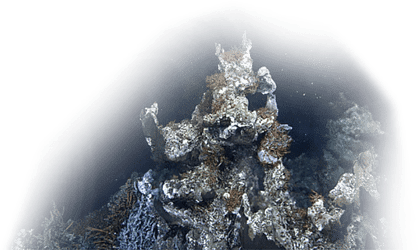This series of forensics experiments began in 2006 when Dr. Gail Anderson, a forensic entomologist from Simon Fraser University deployed the first pig carcass – a human body proxy - at 96m in Saanich Inlet. A subsea camera connected to the VENUS network was the main research instrument to monitor state of the carcass. Using the interactive capability of the networked subsea camera, Dr. Anderson conducted observations, took photos and recorded videos of the events, connecting to camera over the Internet from her home and office at Simon Fraser University as well as at various locations around Canada and the world. Initial results revealed that despite low oxygen conditions in the Saanich Inlet, a large number of crustacea removed the bulk of the soft tissue very rapidly. Captured images and supporting water property observations allowed her to analyze animal behaviour and helped to shed light on the role of various species in the decomposition process.
Paul Macoun, Chantal Turpin and Gail Anderson (left to right) inspect rigging for the forensics experiment, April 2013.
These preliminary results led to the continuation of forensic experiments in Saanich Inlet showing that when oxygen levels dropped too low for the larger crustacea to feed, the carcass remained intact for months until oxygen levels increased enough for the larger crustacea to return and break into the carcass, at which point, the carcass was rapidly consumed. It also led to Dr. Lynne Bell a forensic anthropologist joining the research team to further analyze the recovered skeletal material. In 2012 the work expanded from Saanich Inlet into the Strait of Georgia and now runs in both locations. In 2011/12 Drs. Anderson and Bell received research funding from the Canadian Police Research Centre to continue their research using the VENUS coastal ocean observatory.
Table 1: Carcass Deployments
| Carcass Numbers | Deployment Location | Deployment Season |
|---|---|---|
| 1, 2, 3 | Saanich Inlet | Fall |
| 4, 5, 6 | Strait of Georgia (central node) | Spring |
| 7, 8 | Saanich Inlet | Fall |
| 9, 10 | Saanich Inlet | Spring |
Key Findings
- Decomposition rate varies from hours in Strait of Georgia (large predators) to months in Saanich inlet when oxygen is low (low oxygen, microbial decay only);
- Scavenging rather than decomposition is the major driving factor
- Oxygen levels are the most important abiotic parameter to influence scavenging
- Disarticulation frequently occurs in days, even when oxygen is considered too low for most marine animals to be comfortable.
Forensics platform preparations, April 2013.
References
Anderson G. 2010. Decomposition and invertebrate colonization of cadavers in coastal marine environments. IN: Current concepts in forensic entomology. (Eds) Amendt, J. Goff, ML, Campobasso CP, Grassberger M. 350 p., Hardcover 2010. ISBN: 978-1-4020-9683-9.
Anderson G. 2008. Determination of elapsed time since death in homicide victims disposed in the ocean. Investigation into the effects of oceanic submergence on carrion decomposition and faunal colonization using a baited camera. Canadian Police Research Center, Ottawa, Ontario TR-10-2008.
Anderson G. 2009. Fighting crime on the fly. In Forensic scientist, careers solving crime and scientific mysteries., ed. J. Williams. 1st ed., 55-60. Berkeley Heights, NJ: Enslow Publishers Inc.
Anderson, G.S. and Hobischak, N.R. 2004. Decomposition of carrion in the marine environment in British Columbia, Canada. International Journal of Legal Medicine. 118(4): 206-209.
Bell, L. S. and A. Elkerton (2008). "Human Remains Recovered from a Sixteenth Century Mass Fatality: Unique Marine Taphonomy in Human Skeletal Material from the Medieval Warship the Mary Rose." Int. J. Osteoarch. 18: 523-535.
